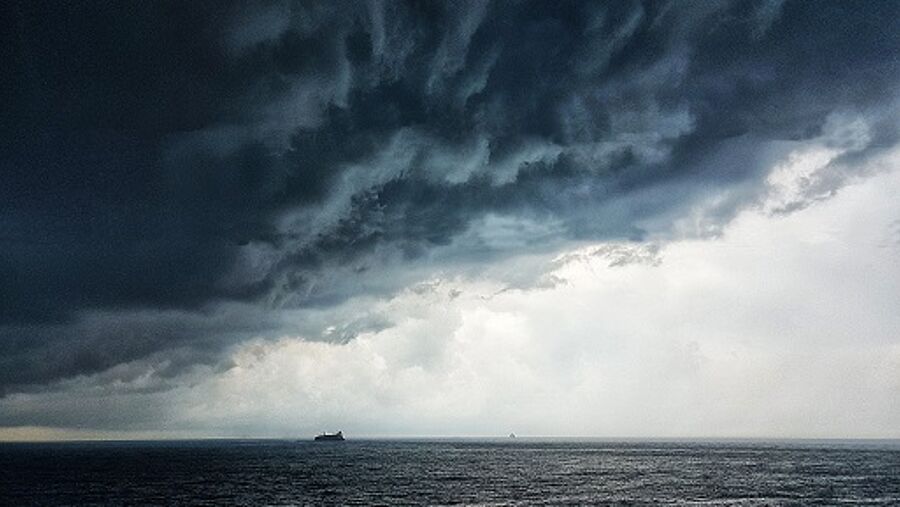
* Pantaenius UK Limited is authorised and regulated by the Financial Conduct Authority (Authorised No.308688)

* Pantaenius UK Limited is authorised and regulated by the Financial Conduct Authority (Authorised No.308688)
Chatting with friends and colleagues in the boating industry it was agreed that a liferaft should be renamed. The name implies it will save our life. And it may. But making the decision to deploy the ‘liferaft’ prematurely could mean disaster. A disaster with no return.
By Jackie Parry

Storms are Brutal!
Storms toss boats around as if they are made of foam. The noise is horrendous. Vortexing winds clutch you in its vicious fist, backing, clocking, in a gut-wrenching horrifying lurch from one direction to another. The cruel gusts pin you down then pick you up and hurl you forward, the great barrelling wall of wind smacks the boat, the walls of water crash into the hull, leaving you wondering why it doesn’t smash into a thousand pieces. Nature puts on a performance of ear-splitting music, the beating halyards and howling winds clashing together, reaching a cliff-hanger crescendo. It’s black, the rigging screeches a death howl. Things break, the boat is out of control, there is water inside, there is mess, you are sick. You are completely and utterly terrified.
You just want to get away from this mayhem. But if you are not sinking you must fight this urge.
Lastraft
A liferaft should be called ‘lastraft’ – as it is the very last thing you can try to save your life. It’s the last-ditch attempt to survive. And it ‘may’ keep you alive – just.
It should be called a lastraft as there is only a few inches of air and thin fabric keeping you alive.
Training
A sea survival course is imperative for anyone going out on the water. But it’s easy to forget that the training cannot reproduce reality. Sitting in the lastraft is a bit of a giggle. Flat water, huddling with strangers, having fun in a swimming pool or protected harbour.
The little dome of orange is comforting; warmth from other bodies and camaraderie gives a false sense of what it would be like.
Reality
If you are in a lastraft, chances are it is due to bad weather. Huge waves will pummel the soft raft, flip you, and make you sick. You will be sitting in urine and vomit and you will be tumbling around mixing with the fluids and with other, heavy bodies… elbows, feet, faces. A diabolical concoction of human waste and limbs.
If two of you are in a six-man lastraft, then prepare for the ride of your life. There will not be enough weight to maintain stability.
If there are two of you in a two-man lastraft, prepare for smelly and uncomfortable intimacy.
Imagine
Imagine how you will go to the toilet if the waves are eight metres high for four days. You can add constipation to the list of realities.
Think about sitting in salt water for days on end (with all the other fluids as mentioned), and what that will do to your skin as you slip-slide.
And before all these quiet contemplations, imagine how on earth you are going to physically get into your lastraft, in total darkness, in big seas with the wind desperately trying to snatch it away from you.
Riding out a Storm in Lastraft
I’ve been through storms but not in a lastraft. I’ve sat in lastrafts, but in calm water. I’ve trained commercial skippers in sea survival. Here, I am simply putting together the horrifying mix that we all want to avoid. But we must think about the possibility, as this could happen to any of us whenever cast off.
When to use a Lastraft
You deploy a lastraft when there is literally nothing else, not a thing. When you have to step up into it. When it is the only thing left to save you.
Easily Said
No, it’s not easy, it’s terrifying. And the decisions made when in the thick of this nightmare must not be judged. We can only discuss, enlighten, and support.
A soft little orange boat sounds like a good idea. You can snuggle inside, close off the storm. After all it is a ‘liferaft’ and you feel like you are going to die.
More often than not your boat can handle it: More often than not, your boat will keep floating. Clearly this depends on the problem and, yes, boats do sink and if this happens you MUST, of course, use your lastraft.
BUT, if they don’t sink THEY ARE YOUR VERY BEST OPTION FOR SURVIVAL.
Tony Bullimore’s story proves this point.
www.abc.net.au/news/2018-07-31/british-sailor-tony-bullimore-dies-aged-79/10058536
The boating community is one of the most supportive groups I have the pleasure to belong to. So, let’s not judge when we’ve not had to face this appalling decision, but please share this article – if it helps just one person pause for thought and reconsider abandoning their ship too early – then it’s worth a moment of our time to share. Please add your thoughts too.
I wish you safe sailing.
Storm Preparation Tips
If you are cruising in a cyclone area during cyclone season, ensure you understand the usual behaviour of the storm within your location. Analyse the best track to sail should you be caught in a cyclone
Click here for more details and a diagram depicting dangerous and navigable semi-circles of a storm/cyclone sistershiptraining.com/2020/08/01/do-you-understand-storms/
What’s in your Ditch Bag? Have you planned?
https://sistershiptraining.com/2019/10/22/ditch-bag-grab-bag-flee-bag/
What is a synoptic chart?:https://sistershiptraining.com/2019/08/25/synoptic-charts/
How to read a synoptic chart:
https://sistershiptraining.com/2019/08/28/how-to-read-a-synoptic-chart/
SisterShip Training is the Safety Partner for Pantaenius Sail & Motor Yacht insurance. Pantaenius customers can contact Jackie and Noel Parry for advice. Jackie@sistershiptraining.com
Jackie and Noel Parry:
sistershiptraining.com
jackie@sistershiptraining.com
Podcasts: sistershiptraining.com/cruising-dreams-into-reality/podcasts/
FB: Turning Your Cruising Dreams into Reality:
www.facebook.com/groups/yourcruisinglife/
Pics
Barometer: A barometer is a widely used weather instrument that measures atmospheric pressure (also known as air pressure or barometric pressure) -- the weight of the air in the atmosphere. It is one of the basic sensors included in weather stations.
Storm Pics.